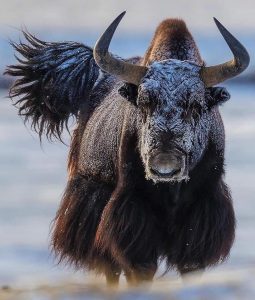ISSN 2768-4261 (Online)

A Journal of Tibetan Literature, Arts and Humanities
Praise to the Lord Yak
Drogön Chogyal Phagpa
(Translated from Tibetan by Lhamo Kyab)
His raincloud body,
vehemently waves in the sky.
From the entrance of his mouth and nose,
vapor spurts like a swirling dark cloud.
His tongue flashes like lighting,
and his grunt resounds like thunder.
The earth is quivered by his striking hooves,
which are like amethyst rock.
Even a massive mountain can be pushed down,
by the tips of his intensely thrusting horns.
His eyes are the sun and moon,
moving like clouds in the sky’s expanse.
His tail is like a great tree.
As it moves, it appears to
Burst the clouds in the sky.
Even melody is completely overwhelmed
by the splendor of his sound
Such a being exists in the Land of Snow,
which is the miracle of the four-footed.
Rare among the two-footed,
can be found one who can compete with him.[1]
May he be victorious
over the merciless human’s weapon.

Photo courtesy: Jed Weingarten
མགོན་གཡག་ལ་བསྔགས་པ།
གང་ལུས་ཆར་སྤྲིན་ཕུང་པོ་ནི།།
མཁའ་ལ་དྲག་ཏུ་གཡོ་ལྟར་སྣང་།།
དེ་ཡི་སྣ་དང་ཁ་སྒོ་ནས།།
རླངས་པ་སྤྲིན་ནག་མཆེད་ལྟར་འཕྱུར།།
ལྕེ་ནི་གློག་ལྟར་འགྱུ་བ་སྟེ།།
ངུར་སྒྲ་འབྲུག་གི་སྒྲ་ལྟར་སྒྲོགས།།
ཨིནྡྲ་ནཱི་ལའི་བྲག་ལྟ་བུའི།།
རྨིག་པ་བརྡབས་པས་ས་གཞི་གཡོ།།
ཤིན་ཏུ་བསྐྱོད་པའི་རྭ་རྩེ་ཡིས།།
རི་བོའི་ལྷུན་ཡང་བསྙིལ་བར་ནུས།།
མིག་གཉིས་ཉི་མ་ཟླ་བ་ནི།།
སྤྲིན་མཐོང་མཁའ་ལ་གཡོ་བ་བཞིན།།
རྔ་མ་ལྗོན་པ་རྒྱས་པ་འདྲ།།
དེ་བསྐྱོད་པ་ཡིས་ནམ་མཁའི་སྤྲིན།།
རྣམ་པར་འཐོར་བ་བཞིན་དུ་སྣང་།།
དེ་ཡི་སྒྲ་ཡིས་གླུ་སྒྲ་ཡང་།།
ཀུན་ནས་རབ་ཏུ་ཟིལ་གྱིས་གནོན།།
འདི་འདྲ་གངས་ཅན་གནས་པ་ཡི།།
རྐང་བཞི་པ་ཡི་ངོ་མཚར་ཏོ།།
འདི་ཡིས་བསྒྲུན་པར་ནུས་པ་ཡི།།
རྐང་གཉིས་པའང་རབ་ཏུ་དཀོན།།
དེ་འདྲ་བརྩེ་མེད་སྐྱེས་བུ་ཡི།།
མཚོན་ལས་རབ་ཏུ་རྒྱལ་གྱུར་ཅིག།
(The original Tibetan poem has appeared in the following sources: Sa chen kun dgaʼ snying po. “mGon gʹyag la bsngags pa.” Sa skya bkaʼ ʼbum, vol. 15, Sakya Center, 1992–1993, pp. 566–566.; ʼGro mgon chos rgyal ʼphags pa, and Sa chen kun dgaʼ snying po. “mGon gʹyag la bsngags pa.” gSung ʼbum (dpe bsdur ma) ʼgro mgon chos rgyal ʼphags pa, Par gzhi dang po, vol. 4, Krung goʼi bod rig pa dpe skrun khang, 2007, pp. 375–375.; Gratitude and Exploration Academic Papers on the Yak Culture of the Qinghai Tibetan Plateau. “mGon gʹyag la bsngags pa.” bod ljongs mi dmangs dpe skrun khang, 2014, pp.261-262.)
Drogön Chogyal Phagpa 1235-1280 (འགྲོ་མགོན་ཆོས་རྒྱལ་འཕགས་པ།) is one of the Five Sakya patriarchs (ས་སྐྱ་གོང་མ་རྣམ་ལྔ།) as well as the nephew of Sakya Pandita. He was the first ruler of Tibet after the collapse of the Tibetan Empire and was the first Tibetan Imperial Preceptor of the Yuan dynasty. In 1244, Sakya Pandita brought with him the two nephews when he visited the royal camp of Godan Khan. Later Kublai Khan asked Godan to give him Chogyal Phagpa as he was interested in Buddhism. So, Drogön Chogyal Phagpa become his tantric guru. Subsequently, he was appointed the National Preceptor in 1260. He developed the concept of the patron and priest relationship. According to Tibetan sources, Kublai Khan granted the three regions of Tibet (Kham, Amdo, and U-Tsang) to Drogön Choeyal Phagpa as payment for the initiation price. Phagpa also received the new title of Imperial Preceptor (Dishi) in 1270 for his invention of the Phagpa script – which had been an official language. In December 1280, Drogon Phagpa passed away in Tibet.
Lhamo Kyab is from the northeast region of Tibet. He is a Ph.D candidate at the Central Institute of Higher Tibetan Studies. He has published the following articles in multiple journals: “A Short Explanation of the Four Great Rivers of Dokham,” “The Correspondence of the Snow-Mountains and Climate of Tibetan Plateau,” “A Brief Biography of Tsang Pandit,” “A Preliminary Research of the Background of the Four Great Rivers/Khabab Zhi” and “A Brief Analysis on War of Tsongon/Kokonor (1723-24)” among others. He translated the book Historiography into the Tibetan Language in 2021 and edited an anthology of the research articles entitled Dung-sgra in 2018.
Notes
[1] In the source “mGon gʹyag la bsngags pa” (1992–1993), this line is written as “འདི་ཡིད་བསྒྲིན་པར་གནས་པ་ཡི།” but it does not make much sense. In the source Gratitude and Exploration (2014), this line is written as “འདི་ཡིས་བསྒྲུན་པར་ནུས་པ་ཡི།།”, which is what is translated here.
© 2021 Yeshe | A Journal of Tibetan Literature, Arts and Humanities